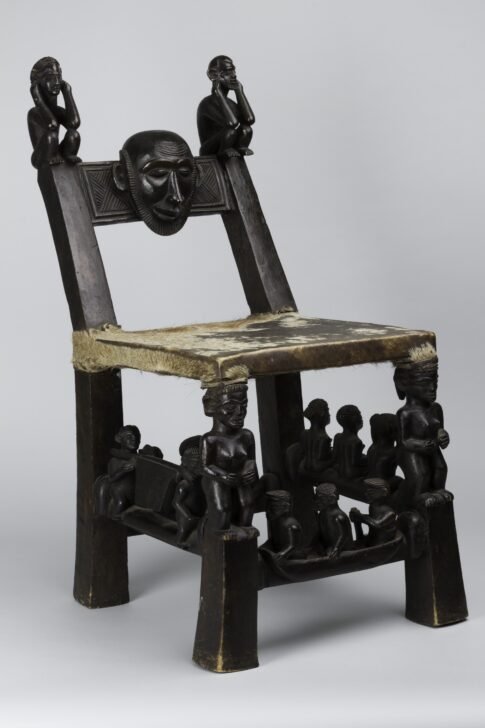Chair
Chokwe

Description
March 28, 2009
In Chokwe society, chairs such as this one represented the authority and supreme spiritual power of their distinguished owners. This chair abounds with symbolism. Two squatting figures decorate the finials. One is elderly, bearded, and scarified, while the other is fresh-faced and young. The space between them marks the transition from boyhood to manhood, which occurs at initiation. Between the figures supporting the chair’s front legs appear three men who raft down a river, a symbolic waterway that suggests the passage between earthly and heavenly worlds.
This chair exemplifies the cross-cultural mixing found in African art. Its shape was inspired by a Portuguese style of leather chair from the late seventeenth century. The carved face at the center is likely a representation of a Portuguese face, suggesting that this chair may have been carved to resemble a much earlier, European commission.
Subject Matter:
Inspired by late 17th century Portuguese prototypes called cadeira de sola, this chair exemplifies the cross-cultural hybridization readily found in African art. Above all, chairs like this represent the authority and supreme spiritual power of its owners: chiefs, elders, diviners, or circumcision specialists. When presiding over local disputes, dignitaries leaned on citwamo ca mungu while sitting on animal hides. The chair is dyed with vegetal infusion or stained with castor oil.
Physical Description:
This wooden chair has two squatting figures decorating the finials; one is elderly, bearded, and scarified, while the other is fresh-faced and young. At the lower left rung, two men carry a slit drum; between the caryatid figures supporting the chair’s front legs appear three men; the central slat has incised diagonal patterns called fuliko. At the center, what is possibly a pointy-nosed European’s face replaces the more habitual chikungu masker.
Usage Rights:
If you are interested in using an image for a publication, please visit https://umma.umich.edu/request-image/ for more information and to fill out the online Image Rights and Reproductions Request Form.